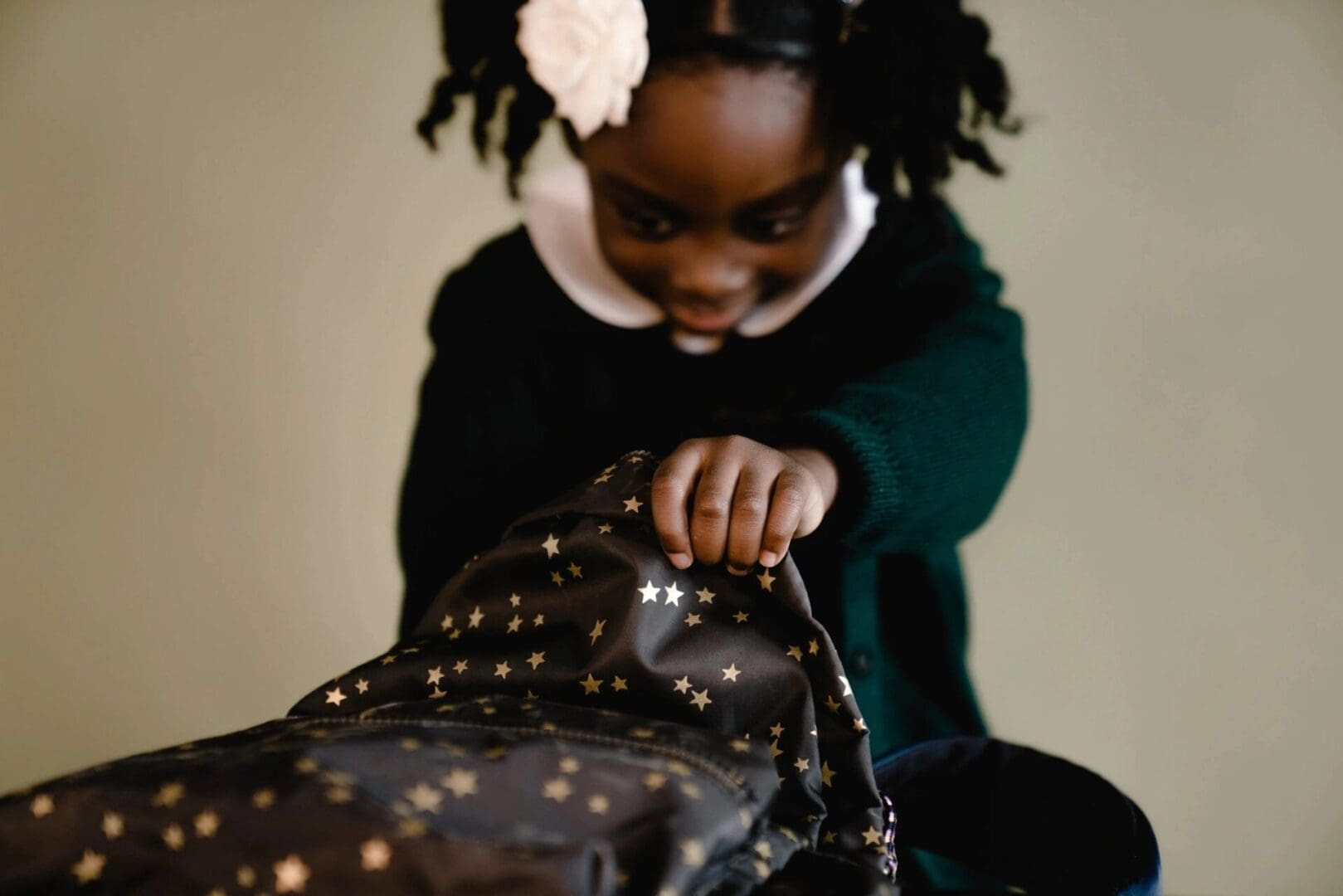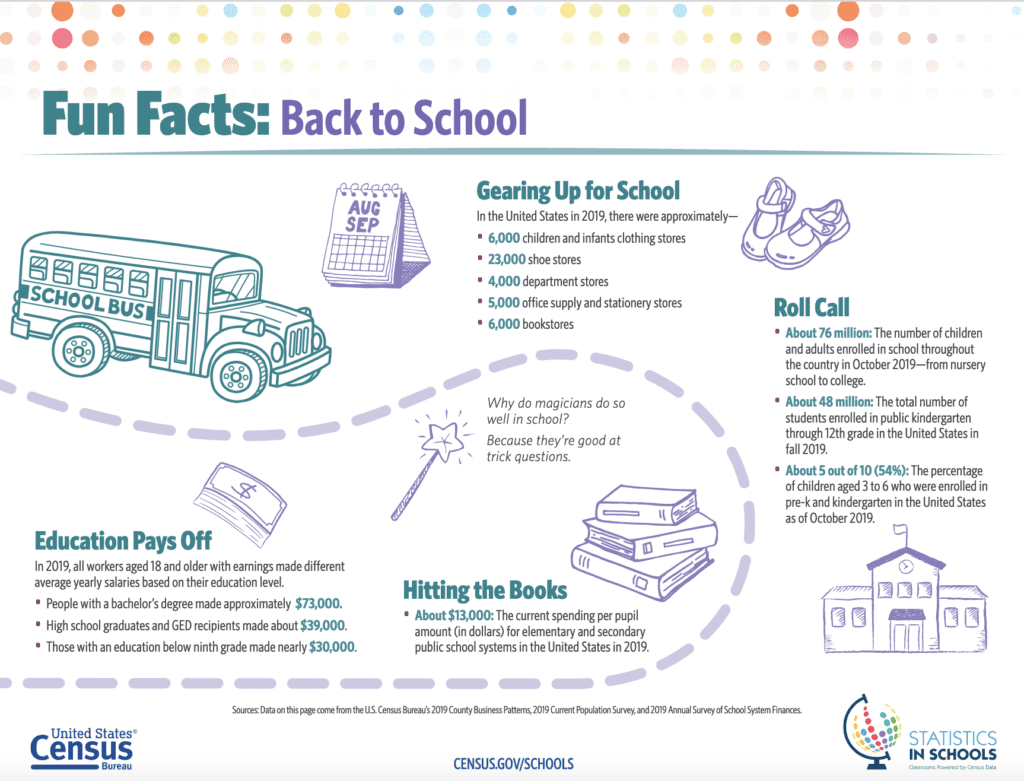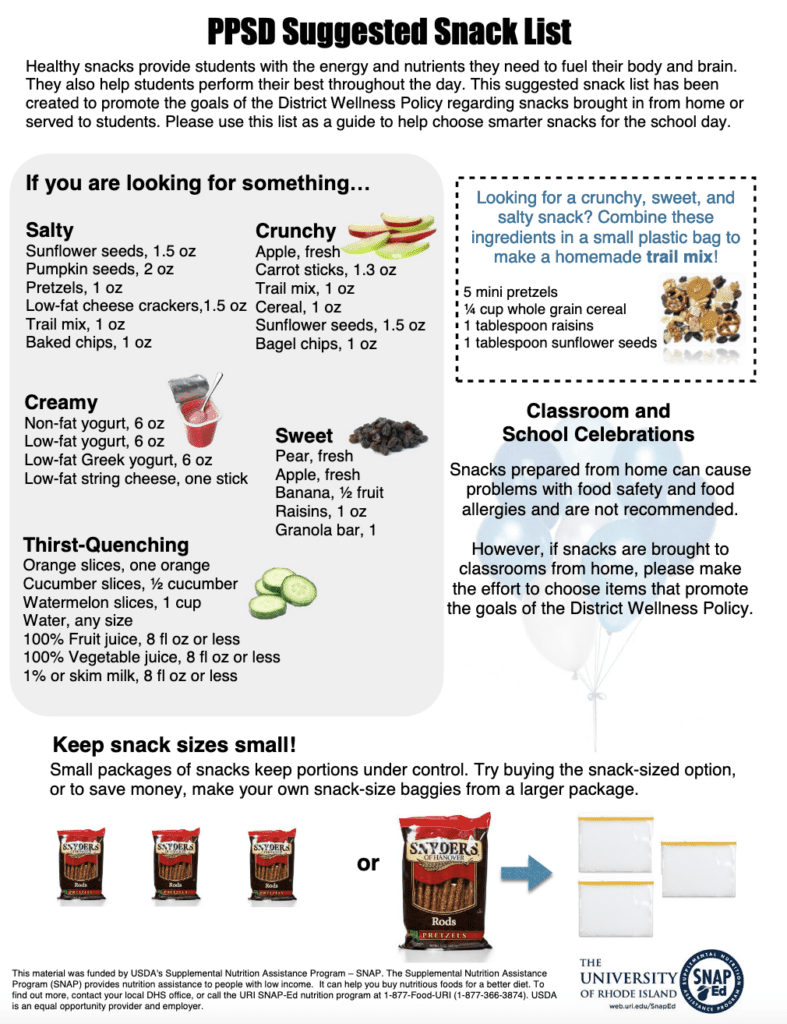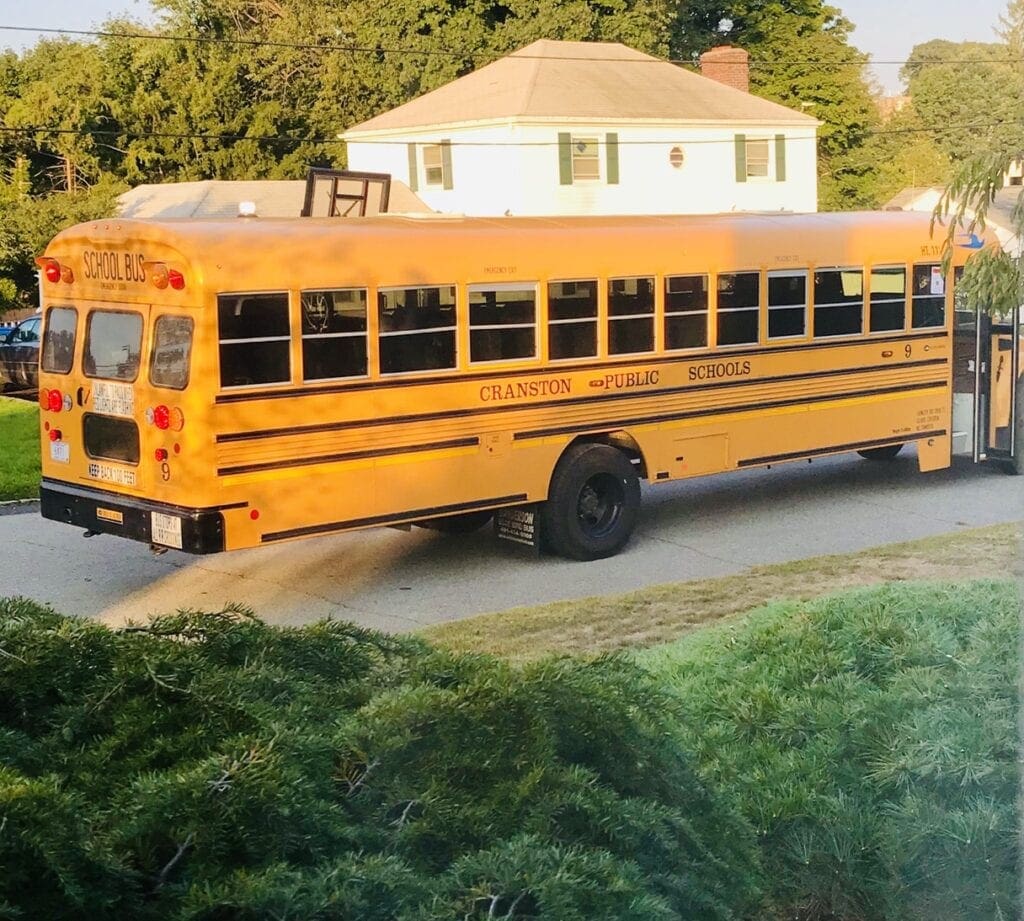Search Posts
Recent Posts
- RI Veterans: Did you know? 25.04.24 (100th for Louis Dolce, events, resources) – John A. Cianci April 25, 2024
- Business Beat: Bad Mouth Bikes takes home 3 national awards April 25, 2024
- Rhode Island Weather for April 25, 2024 – John Donnelly April 25, 2024
- We Cook! Mill’s Tavern’s Cajun North Atlantic Swordfish, Mango Salsa, Cilantro Citrus Aioli April 25, 2024
- The Light Foundation & RI DEM’s 4th Annual Mentored Youth Turkey Hunt a success April 25, 2024
Categories
Subscribe!
Thanks for subscribing! Please check your email for further instructions.

Back-to-School advice & tips
It’s back-to-school time and we’re sharing some very useful Back-to-School tips and resources from safety tips to healthy snacks…
From the U.S. Census:

_____
The Westport Fire Department Back-To-School Safety Tips
To coincide with the start of the new school year, Superintendent Thomas F. Aubin of the Westport Fire Department offers tried and true safety tips for getting to and back from school.
“We are eager to begin this new school year, but want to ensure everyone is safe while entering or exiting school property,” Superintendent Aubin said. “Parents should review these important safety tips with their children, regardless of their age.”
Traveling to School Safety
The National Safety Council (NSC) provides the following tips for students and parents to safely get to school:
Walking to school:
Walk on the sidewalk, if one is available; when on a street with no sidewalk, walk facing the traffic
Before crossing the street, stop and look left, right and left again to see if cars are coming
Make eye contact with drivers before crossing the street and always cross streets at crosswalks or intersections
Stay alert and avoid distracted walking. Never walk while texting. If you need to respond to a text, move out of the way of others and stop on the sidewalk. Never cross the street while using an electronic device. Do not wear earbuds while walking across the street.
Riding a bike to school:
Ride on the right side of the road, with traffic, and in single file
Come to a complete stop before crossing the street; walk bikes across the street
Stay alert and avoid distracted riding
Make sure your child always wears a properly fitted helmet and bright clothing
Helmets appropriate for bicycling should be worn by everyone – adults and children – on every bike ride regardless of length of the ride.
Riding the bus to school:
Go to the bus stop with your child to teach them the proper way to get on and off the bus
Teach your children to stand six feet (or three giant steps) away from the curb
If your child must cross the street in front of the bus, teach him or her to walk on the side of the road until they are 10 feet ahead of the bus; your child and the bus driver should always be able to see each other
Driving your child to school:
Stay alert and avoid distracted driving
Obey school zone speed limits and follow your school’s drop-off procedure
Make eye contact with children who are crossing the street
Safety Tips for Motorists
It is important that motorists be alert while driving, especially in school zones and residential neighborhoods. Children can be unpredictable and may ignore hazards and take risks. The NSC provides the following tips for motorists:
Don’t block the crosswalk when stopped at a red light or waiting to make a turn, forcing pedestrians to go around you; this could put them in the path of moving traffic
In a school zone when flashers are blinking, stop and yield to pedestrians crossing the crosswalk or intersection. Always stop for a school patrol officer or crossing guard holding up a stop sign
Take extra care to look out for children in school zones, near playgrounds and parks, and in all residential areas
Don’t honk or rev your engine to scare a pedestrian, even if you have the right of way
Never pass a vehicle stopped for pedestrians
If you’re driving behind a bus, allow a greater following distance than if you were driving behind a car
Never pass a bus from behind – or from either direction if you’re on an undivided road – if it is stopped to load or unload children. It is illegal in all 50 states to pass a school bus that is stopped to load or unload children
If the yellow or red lights are flashing and the stop arm is extended, traffic must stop
The area 10 feet around a school bus is the most dangerous for children; stop far enough back to allow them space to safely enter and exit the bus
When passing a bicyclist, proceed in the same direction slowly, and leave 3 feet between your car and the cyclist
The most common cause of collision is a driver turning left in front of a bicyclist. Watch for bike riders turning in front of you without looking or signaling; children especially have a tendency to do this
Watch for bikes coming from driveways or behind parked cars
As always, if there’s any emergency call 9-1-1- immediately.
The Westport Community Schools wishes everyone a happy and safe return to school!
_____
Music Can Safely Return to RI Schools – RIMEA Shares Updated Music Guidance
The Rhode Island Music Education Association (RIMEA) released updated music guidance today ahead of the re-opening of schools in the fall. The guidance will allow state and local leaders to focus on re-opening music education programs in order to support the social and emotional well-being of Rhode Island students. The updated guidance, which mirrors guidance previously published by the Rhode Island Department of Education outlines mitigation strategies for indoor and outdoor music classes, as well as bell covers, masks and distancing.
“The importance of in-person learning extends to all subjects, including music, at all grade levels,” said David Neves, Advocacy Co-Chair at RIMEA. “The update guidance includes safe and practical ways for students and teachers to hold these essential music classes.”
Access the Music Guidance, here: PreK-12 Health and Safety Guidance for the
2021-2022 School Year – https://www.back2schoolri.com/wp-content/uploads/2021/06/2021-PK-12-Fall-Guidance.FINAL1_.pdf
_____
Healthy Snack Ideas for Back-to-School
The Providence school Department and SNAP has a handy list of what type of snacks to pack for your child, young and old – to keep that healthy energy up all day long.

CDC provides these tips for back-to-school in COVID times:
CDC offers these health tips that will make for a successful school year for students, teachers, school staff and their families.
- Take COVID-19 seriously. Students benefit from in-person learning and safely returning to in-person instruction in the fall 2021 is a priority. CDC has COVID-19 specific guidance for K-12 schools and Colleges and Universities.
- Mental health is important to the learning process. CDC data shows that the pandemic has created significant stress and trauma for children, adolescents, and families. Schools can help promote student well-being with CDC evidence-based strategies like establishing safe and supportive school environments and referring students to appropriate mental and physical health services.
- Routine vaccinations save lives. Getting required vaccines can help protect children and teens as they grow into adulthood. Making sure children get vaccinated is one of the most important things parents can do.
- Washing hands stops germs. Handwashing with soap and water is one of the best ways to remove germs, avoid getting sick, and prevent the spread of colds, flu, and other diseases to others.
- Eat well, be active, and get enough sleep. Make sure children drink plenty of water, limit sugary drinks, and practice healthy eating at home and school to help achieve and maintain a healthy weight and to support brain development and healthy growth. It’s also important to help kids get the recommended 60 minutes or more of daily physical activity, as well as the right amount of sleep every night. Teens need at least 8 hours of sleep per night—younger students need at least 9 hours.
- Be tobacco free. Youth use of any tobacco product is unsafe. E-cigarettes are the most commonly used tobacco product among U.S. middle and high school students. However, youth also report using cigarettes, cigars, smokeless tobacco, and other tobacco products. Tobacco products contain nicotine which is highly addictive and can harm the developing adolescent brain – specifically the areas of the brain that are responsible for learning, memory, and attention. For help to quit, you can talk with your healthcare provider or visit CDC.gov/quit.
- Stay cool in the heat. With above average temperatures in multiple parts of the country, it is important to limit outdoor activity during the middle of the day when the sun is hottest. Wear and reapply sunscreen, seek shade, drink plenty of water, and know how to prevent heat-related illness in athletes.
- Wear helmets and protect your head. Children and adolescents can get a concussion in any number of school settings ranging from school sports activities to the hallway, the playground, and even the cafeteria. Get information on preventing and responding to concussions and supporting students when they return to school after a concussion.
- Help children with special health care needs. The pandemic can present unique challenges for children with special health care needs. CDC has tips for helping these children make the transition back to the classroom.
The bottom line
Healthy students are better learners. Following these health tips can lead students to a successful and healthy school year. For additional information on health and learning, visit CDC’s Healthy Schools site and CDC’s adolescent health page to learn why schools are the right place for a healthy start.

From Discovery Point, a private day care franchise, some basic tips for success in transitioning from hybrid or remote learning to in-person learning again:
Here are our tips for being as prepared as possible for back-to-school time, how to roll with the punches, and how to help your children thrive after such an uncertain year.
Tip #1: Set Expectations
Explain to your children that this year’s school experience may look different than years prior. Depending on the school district, they may be required to wear masks, and certain forms of social distancing may be in force.
After hearing for so long that it was unsafe to go to school or meet with friends, they may have questions or anxieties about whether it is safe to go back now. Take the time to answer their questions using age-appropriate language, and gently let them know that “normal” could continue to be a changing concept.
Tip #2: Set Standards
While remote learning definitely had its drawbacks, there were some benefits your child is sure to miss. Rolling out of bed and studying in their pajamas was convenient and comfortable, but those days are behind us. Remind your child about what kind of attire is appropriate for school and how much earlier they will need to wake up to get ready and get out the door.
Tip #3: Get the Morning Routine Down Pat
If at all possible, aim to get into a more formal morning routine several weeks before school actually starts. This will allow your children to gradually set their alarm clocks earlier and earlier, rather than feeling they’ve been rudely awakened on that important first day. See how long it takes to have them get dressed and eat a healthy breakfast, and add on a few extra minutes of buffer time to ensure there’s no need to rush when school season finally arrives.
Tip #4: Create an Evening To-Do List
The best way to make your morning routine stress-free is to take care of any time-consuming activities the night before. Write down an evening to-do list on the refrigerator or near the family calendar including tasks such as:
- Preparing lunch
- Packing the backpack
- Laying out an outfit
- Checking that breakfast foods are on hand
- Setting the alarm clock
Tip #5: Schedule in Plenty of Family Time
This past year, many families have had a lot more time together than they ever expected. Suddenly having to spend hours away from you and from home every weekday may cause anxiety for kids who love routine.
Help ensure your children feel supported and get that much-needed family time they’ve become accustomed to by blocking off chunks of your own schedule in the evening after school. Having a set family dinner time where they can talk about their day will give them space to verbalize their anxieties and have something to look forward to each evening after a long day at school.
Whether your child is thrilled to go back to school and see their friends or is hesitant about the many changes ahead, they may need your support to get into the swing of things. Let your child know they’re not alone in this new adventure. Remind them that you’ll be facing any challenges that arise together, and you’ll always be there for them no matter what the upcoming school year holds.
